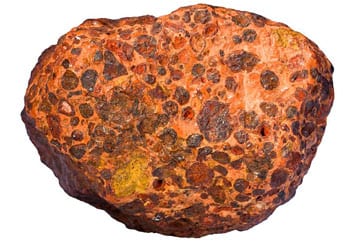Select Language:
Aluminum waa element ah birta ugu badan helay on Earth, totaling about 8% oo ka mid ah dhulka udubyadiisa. Si kastaba ha ahaatee, aluminum as an element is reactive and therefore does not occur naturally – it needs to be refined to produce aluminum metal. Qoraalkani wuxuu ku bilaabo aasaasiga ah ee turxaan aluminium waa bauxite, isha ugu weyn dunida ee ganacsi ee aluminium. Bauxite is a sedimentary rock, and consists mostly of the aluminium minerals gibbsite (Al(OH)3), boehmite (c-ALO(OH)) iyo diaspore (a-ALO(OH)), and is usually mixed with the two iron oxides goethite and hematite, the aluminium clay mineral kaolinite and small amounts of anatase (TiO2) and/or ilmenite (FeTiO3).

kayd bauxite yihiin caalamka oo dhan faafidda, inta badan ka dhaca gobollada kulaylaha ama dadka fareen. Although proven reserves of bauxite are expected to last for many years, tayada kaydka ah waa in laga heli karaa dhaqaale hoos u. Waayo, dahabtumayaashii, who are in the business of bauxite processing to make alumina, iyo biraha ugu danbeyn aluminium, tani waa caqabad ku ah labada saamaynta dhaqaale iyo deegaanka.
The process to refine metallurgical bauxite into alumina involves the following inputs:
The following outputs are generated:

The most widely used chemical process of refining bauxite into alumina, hawsha Bayer, involves dissolving the Al2O3 out of the bauxite rock with caustic soda (NaOH) at elevated temperature and pressure. The Al2O3 fraction of the bauxite is dissolved into solution, to later be precipitated out as alumina. Si kastaba ha ahaatee, a high-grade bauxite contains up to 60% Al2O3, and many operating bauxite deposits are well below this, mararka qaar yar intii 30-40% Al2O3. Because the desired product is a high purity Al2O3, oxides haray in bauxite ah (Fe2O3, SiO2, TiO2, Organic material) are separated from the Al2O3 and rejected as alumina refinery resides (Aar oo) or red mud. Guud, tayada hoose bauxite ah (ie lower Al2O3 content) the more red mud is generated per ton of alumina product. Intaa waxaa dheer, even some Al2O3 bearing minerals, gaar ahaan kaolinite, produce un-desirable side reactions during the refining process and lead to an increase in red mud generation, iyo sidoo kale khasaaraha ka mid ah mid qaali ah kiimikada Soodhaha, kharashka variable weyn ee geedi socodka turxaan bauxite.
dhoobo Red ama Aar oo ka dhigan mid weyn iyo mid ku socda tartan loogu talagalay warshadaha aluminium ah. dhoobo Red ku jira dhamayta haraaga kiimikada hadhay weyn ka geedi socodka turxaan ah, oo waa heer sare ah xumadoodu, oo inta badan leh pH ah 10 - 13. It is generated in large volumes worldwide – according to the USGS, lagu qiyaasay saarka alumina caalamiga ahaa 121 million tons in 2016. This likely resulted in more than 150 million tons of dhoobo cas ahbaa isla muddadaas. In kasta oo cilmi-socda, dhoobo cas hadda dhowr Waddooyinkiisa ganacsi-gal ah in ay faa'iido dib-u-isticmaalka. Waxaa lagu qiyaasaa in aad u yar ee dhoobo cas beneficially waa dib-u-loo isticmaalo dunida oo dhan. Instead the red mud is pumped from the alumina refinery into storage impoundments or landfills, halkaasoo lagu kaydiyo oo lagula socdaa qiimaha weyn.
Guuldaradii ugu of Soodhaha qaali (NaOH) and the generation of red mud are both related to the quality of the bauxite used in the refining process. Guud, the lower the Al2O3 content of the bauxite, mugga weyn ee dhoobo cas in la ahbaa doonaa, as the non-Al2O3 phases are rejected as red mud. Intaa waxaa dheer, the higher the kaolinite or reactive silica content of the bauxite, dhoobada more cas loo ahbaa doonaa. The reactive silica content not only increases the volume of red mud, but also consumes caustic soda reagent and reduces the yield of Al2O3 recovered from the bauxite. Sidaa darteed, there is both an economic and environmental argument to be made for improving the quality of bauxite prior to refining.
The dalab habka STET qalalan-soociddiisa bauxite saarayaasha ama dahabtumayaashii bauxite fursad ay ku qabtaan casriyeyn pre-Bayer-habka of ore bauxite si loo hagaajiyo tayada. Habkan leedahay faa'iidooyin badan:
Marka la soo koobo, processing engeg ah fursadaha dalabyo SEPARATOR STET in ay curiyaan qiimaha soo saarayaasha bauxite iyo dahabtumayaashii. The pre-processing ah bauxite ka hor turxaan hoos u dhigi doontaa kharashka kiimikada, hoos mugga of dhoobo cas ahbaa iyo in la yareeyo khalkhal habka.
tixraacyada: